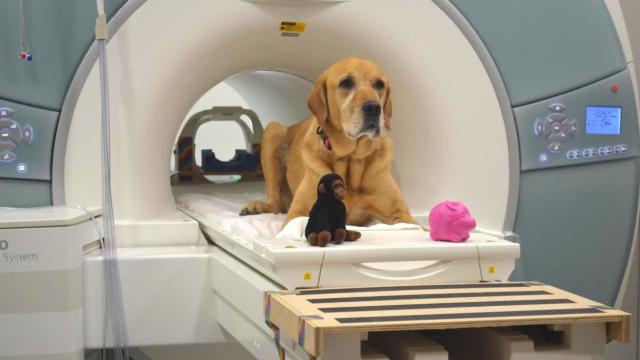If you’re a dog person who has suspected that your four-legged friend may know exactly what you mean when you use certain words or phrases—for example “toy,” or “car,” or maybe even “who’s the good boy?” (he is) — you may be correct.
A new study by scientists at Emory University and published Monday in the journal Frontiers in Neuroscience suggests dogs possess a basic understanding of the words they’ve been taught to associate with objects. After training 12 very good dogs of different breeds over the course of two to six months to discern between two toys based on their respective names, the researchers then utilised functional magnetic resonance imaging (fMRI) to study whether they possessed a basic ability to differentiate between human speech they were taught to remember and new or unfamiliar words.
“Many dog owners think that their dogs know what some words mean, but there really isn’t much scientific evidence to support that,” Ashley Prichard, a Ph.D. candidate in Emory’s Department of Psychology and the first author of the study, said in a statement. But rather than simply take anyone on their word that their dog is smart as hell, or by contrast a “loveable idiot,” the researchers opted to “get data from the dogs themselves.”
In order to differentiate the two training objects used for each dog, researchers picked both a soft object and one of a different texture; for example, a stuffed animal and a squeaky toy. Using what the study describes as “Chaser Protocol,” the dogs were then trained to fetch the objects based on those objects’ names (e.g. “piggy” versus “monkey”). The dogs were then rewarded with treats and praise for correctly associating an object with its name.
The owners of the participating dogs worked with them on identifying each object for approximately 10 minutes per day until they “showed the ability to discriminate between the trained and novel object, at which point they progressed to discrimination training between the two trained objects.”
During fMRI testing, the primary owners of the dogs were positioned in front of them at the machine’s opening. The four test types used for the study included expected, unexpected, pseudoword, and reward, all of which were presented semi-randomly. For example, during expected trials, owners said the name of the object a pup had been trained to remember five times at a speed of once per second before showing the object to the dog. For unexpected trials, the owner repeated the name of the trained object but then showed the dog a novel object it hadn’t been trained to recognise (such as a Barbie doll, wooden train whistle, or yellow hat). And in pseudoword trials, owners repeated gibberish words—e.g. “thozz,” “sowt,” “bodmick,” and “stru,” all of which were selected using a pseudoword generator—before subsequently showing the dogs novel objects.
Compared with previous research, this study is exciting because it focuses on whether dogs can understand human speech, rather than words combined with intonation and/or gestures, Emory neuroscientist Gregory Berns, a senior author of the study, said in a statement.
“We know that dogs have the capacity to process at least some aspects of human language since they can learn to follow verbal commands,” he said. “Previous research, however, suggests dogs may rely on many other cues to follow a verbal command, such as gaze, gestures and even emotional expressions from their owners.”
If you are wondering how these people got the dogs got into the MRI machine, all 12 of the doggos had participated in training for other fMRI experiments. But guys, these dogs “demonstrated the ability to remain still during training and scanning,” underscoring again how very good they are.
Researchers observed that the dogs displayed greater brain activation to the made-up words than the ones they’d been trained to recognise. The areas of the brain in which the dogs showed increased neural activity was different in some pups over others, but the researchers said that could be attributed to differences in the sizes and shapes of the dogs’ brains relative to their breed and cognitive abilities. Interestingly, this is the opposite of how human brains react to words they don’t know.
“We expected to see that dogs neurally discriminate between words that they know and words that they don’t,” Prichard said. “What’s surprising is that the result is opposite to that of research on humans — people typically show greater neural activation for known words than novel words.”
Ultimately, researchers think that dogs may respond to “novel words” the way they do because they know we want them to understand us, and they want to please us—or perhaps, as Berns said, “also receive praise or food.”
Yet more evidence that while dogs may eat their own shit, they are still very good.
